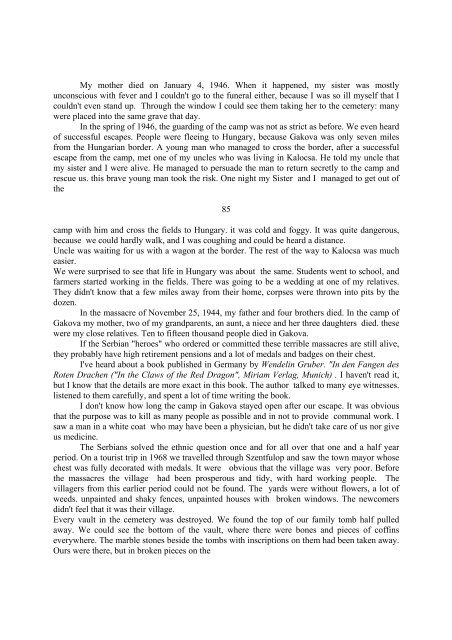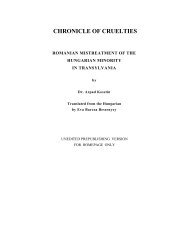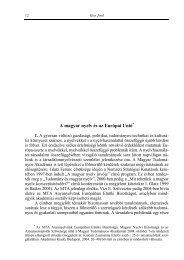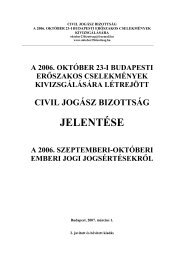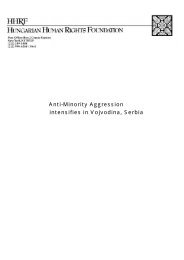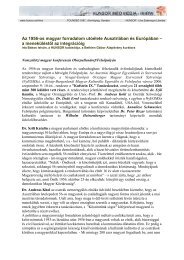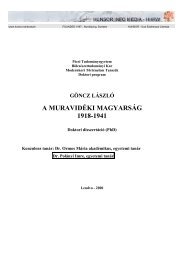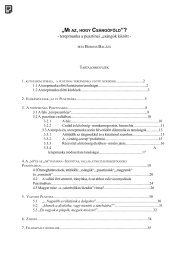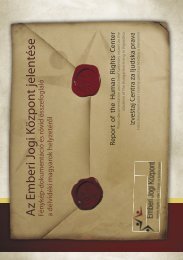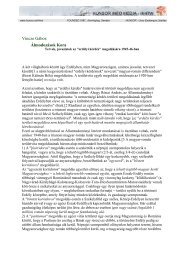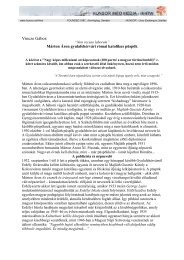PLEASE NOTE: This book contains graphic description ... - HUNSOR
PLEASE NOTE: This book contains graphic description ... - HUNSOR
PLEASE NOTE: This book contains graphic description ... - HUNSOR
You also want an ePaper? Increase the reach of your titles
YUMPU automatically turns print PDFs into web optimized ePapers that Google loves.
My mother died on January 4, 1946. When it happened, my sister was mostlyunconscious with fever and I couldn't go to the funeral either, because I was so ill myself that Icouldn't even stand up. Through the window I could see them taking her to the cemetery: manywere placed into the same grave that day.In the spring of 1946, the guarding of the camp was not as strict as before. We even heardof successful escapes. People were fleeing to Hungary, because Gakova was only seven milesfrom the Hungarian border. A young man who managed to cross the border, after a successfulescape from the camp, met one of my uncles who was living in Kalocsa. He told my uncle thatmy sister and I were alive. He managed to persuade the man to return secretly to the camp andrescue us. this brave young man took the risk. One night my Sister and I managed to get out ofthe85camp with him and cross the fields to Hungary. it was cold and foggy. It was quite dangerous,because we could hardly walk, and I was coughing and could be heard a distance.Uncle was waiting for us with a wagon at the border. The rest of the way to Kalocsa was mucheasier.We were surprised to see that life in Hungary was about the same. Students went to school, andfarmers started working in the fields. There was going to be a wedding at one of my relatives.They didn't know that a few miles away from their home, corpses were thrown into pits by thedozen.In the massacre of November 25, 1944, my father and four brothers died. In the camp ofGakova my mother, two of my grandparents, an aunt, a niece and her three daughters died. thesewere my close relatives. Ten to fifteen thousand people died in Gakova.If the Serbian "heroes" who ordered or committed these terrible massacres are still alive,they probably have high retirement pensions and a lot of medals and badges on their chest.I've heard about a <strong>book</strong> published in Germany by Wendelin Gruber. "In den Fangen desRoten Drachen ("In the Claws of the Red Dragon", Miriam Verlag, Munich) . I haven't read it,but I know that the details are more exact in this <strong>book</strong>. The author talked to many eye witnesses.listened to them carefully, and spent a lot of time writing the <strong>book</strong>.I don't know how long the camp in Gakova stayed open after our escape. It was obviousthat the purpose was to kill as many people as possible and in not to provide communal work. Isaw a man in a white coat who may have been a physician, but he didn't take care of us nor giveus medicine.The Serbians solved the ethnic question once and for all over that one and a half yearperiod. On a tourist trip in 1968 we travelled through Szentfulop and saw the town mayor whosechest was fully decorated with medals. It were obvious that the village was very poor. Beforethe massacres the village had been prosperous and tidy, with hard working people. Thevillagers from this earlier period could not be found. The yards were without flowers, a lot ofweeds. unpainted and shaky fences, unpainted houses with broken windows. The newcomersdidn't feel that it was their village.Every vault in the cemetery was destroyed. We found the top of our family tomb half pulledaway. We could see the bottom of the vault, where there were bones and pieces of coffinseverywhere. The marble stones beside the tombs with inscriptions on them had been taken away.Ours were there, but in broken pieces on the


